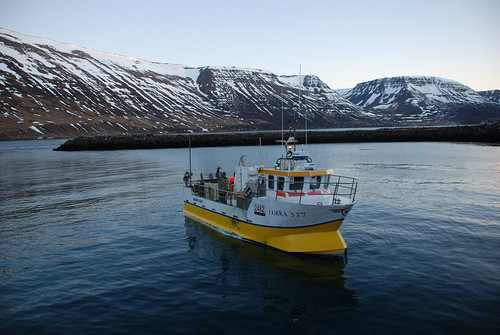
This is the final post in my Icelandic Saga... and the post is likely to be a saga in itself...
There is a magnificent approach to the village of Sudeyreri, which is found on the farthest tip of Iceland's West Fjords. During the winter the fastest way (weather permitting) is to fly from Rekyavik, in some sort of modernised Short's 360. Anyone who flew Aer Lingus across the Irish Channel in the 90's would probably recognise the aircraft by the name 'vomit comet'.
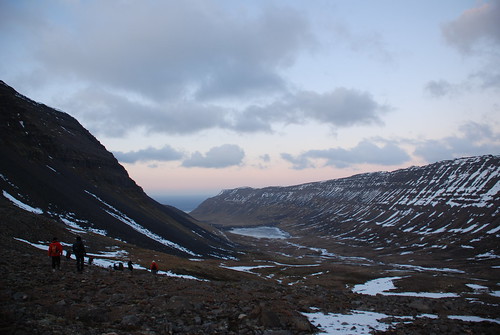
The descent into the West Fjords is a treacherous one. At an altitude of only several hundred feet, the plane races up and down the valleys in a very particular pattern, zipping over warning beacons and performing tight turns around lit poles. There is something of the aerobatic race about it. Then suddenly the engines throttle back completely, and you drop the last few feet onto the icy runway at Thinkery.
The little arrivals building was mostly crowded with parents and families waiting for their returning children; and so tight was the space, and so intimate the atmosphere, that it took on the appearance of a living room with a conveyor belt running through it. Outside, a massive Swedish truck from the 70's painted a dashing red and upholstered in several tints of brown took us up into the tunnel. Until relatively recently Sudeyreri was completely cut off for about four months every year. A mammoth construction project... a tunnel several miles long cut through the mountains... was the solution. Perfectly straight, its vaults lit up like a medieval banquet hall.
The village, only 350 people, is completely centred around the fishing industry, and is run by a type of benign protector – Odin – the owner of the fish factory and fish drying house. He employs only couples, in an effort to build up the population of the village, and owing to the fact that in his experience men make better fishermen, while women have better attention spans for skilfully de-boning fish for hours on end. "There are no men on my factory floor" he said "they just lose concentration and mess things up." They do however employ the local kids, who, when there is a large haul of fish, will work for a few hours after school to make up the numbers. These same kids, with nothing much to do, have discovered the joys of putting your back flips on youtube, and composing black metal music (brot were practising in the church when we arrived).
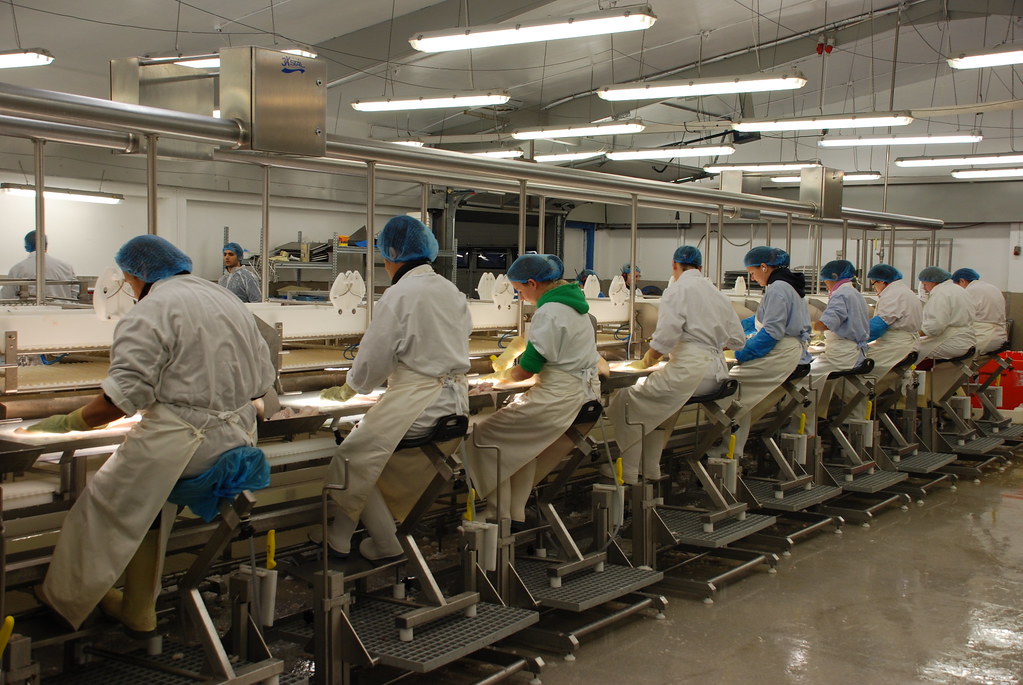
The all-female factory workforce. De-boning takes place on thick perspex light boxes, the rhythmic flick and swish of the knives barely audible over the hum of the central conveyor belt.
There is such a rationally organised system to the village: everyone works for the company, which invests in the school and donates money for local amenities. The whole place is powered by the hydroelectric plant installed on a local farm, and by a small geothermal plant in the town centre. There was something vaguely socialist about the single party equal distribution of profit. One night I had dinner with a local family and asked, bathed in the glow of their enormous television, would it not be a good idea to make the fish factory a union-run venture, organised by the people of the village? But they seemed against this: it was wiser and more efficient to have Odin at the helm (so to speak).
Another time, I went out on one of the small fishing boats. Myself and two friends, an Italian and a Swede, packed into the tiny vessel, and set out for the Arctic circle. The system of fishing, which is conducted in the eternal night of Arctic winter, is done using a long line (comprised of 24 segments) onto which bait is tied. The line takes about 3 hours to spool out, and then 6 hours to reel in. The two fisherman stand at an open hatch, waiting for the incoming line to present whichever fish it has caught. These are stabbed with a hook on the end of a stick and flicked into a large tray. Here they are killed by the other fisherman and slung into the hold (being sorted by species). A good haul would be about 4 tons.
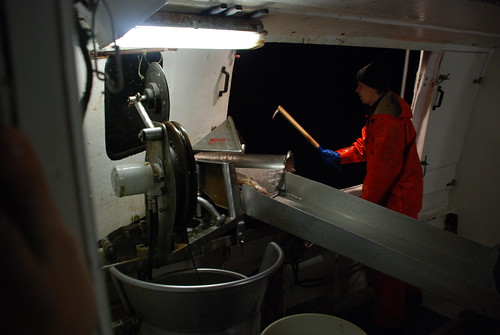
The weather was particularly violent when we went out (though I am proud to say that of the 15 in my group that went out in several boats, I was one of only 3 that were not constantly ill), with the swell over 3 metres. It was so rough that we had to abandon a spot where it was known there were plenty of fish. While turning south to shallower waters the swell caused our line to snap, and we spent a good hour roaming around the outer Arctic circle looking for the flashing buoy – a pinprick of red in an ocean of black. The line had dragged along the bottom, and had picked up a wild assortment of sea-creatures, some of which I don't really even know how to describe. Amongst them was a giant crab, with a pincer the size of a child's hand, at least 50cm across. Due to the weather we pulled in just under two and a half tons.

The last buoy coming in, around 1pm, after 10 hours at sea. The waters had irritatingly calmed by the time the light came, making photographic evidence of the storm impossible. At its height, the boat had switched on a search lamp to see how bad it was – the beam cut straight through the high waves rolling over the deck, lighting up crystal turquoise mountains all around us.
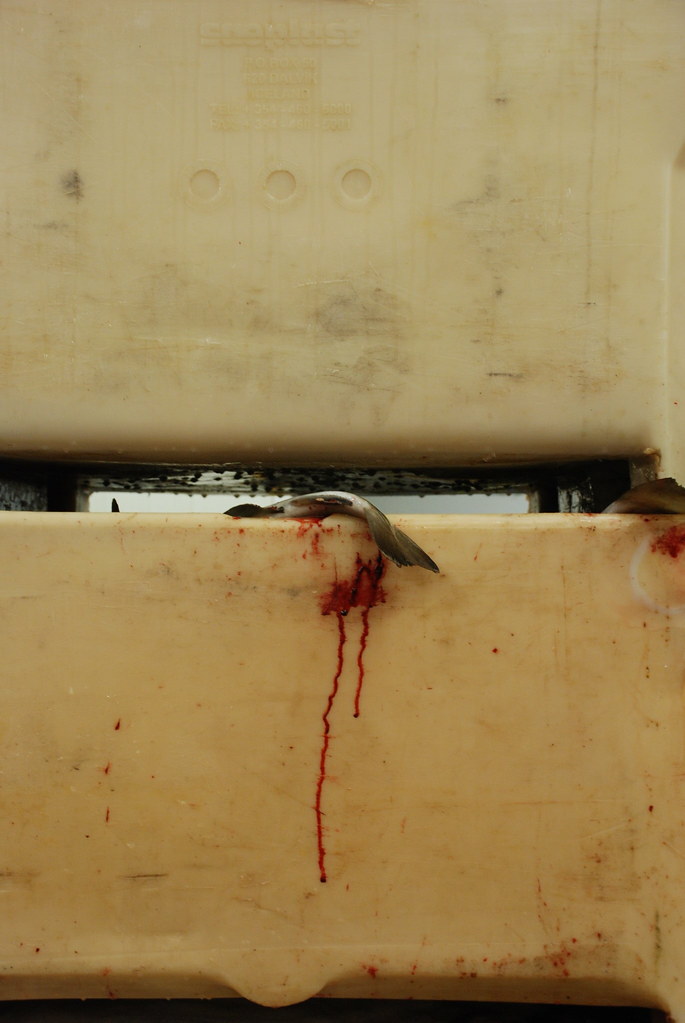

No comments:
Post a Comment